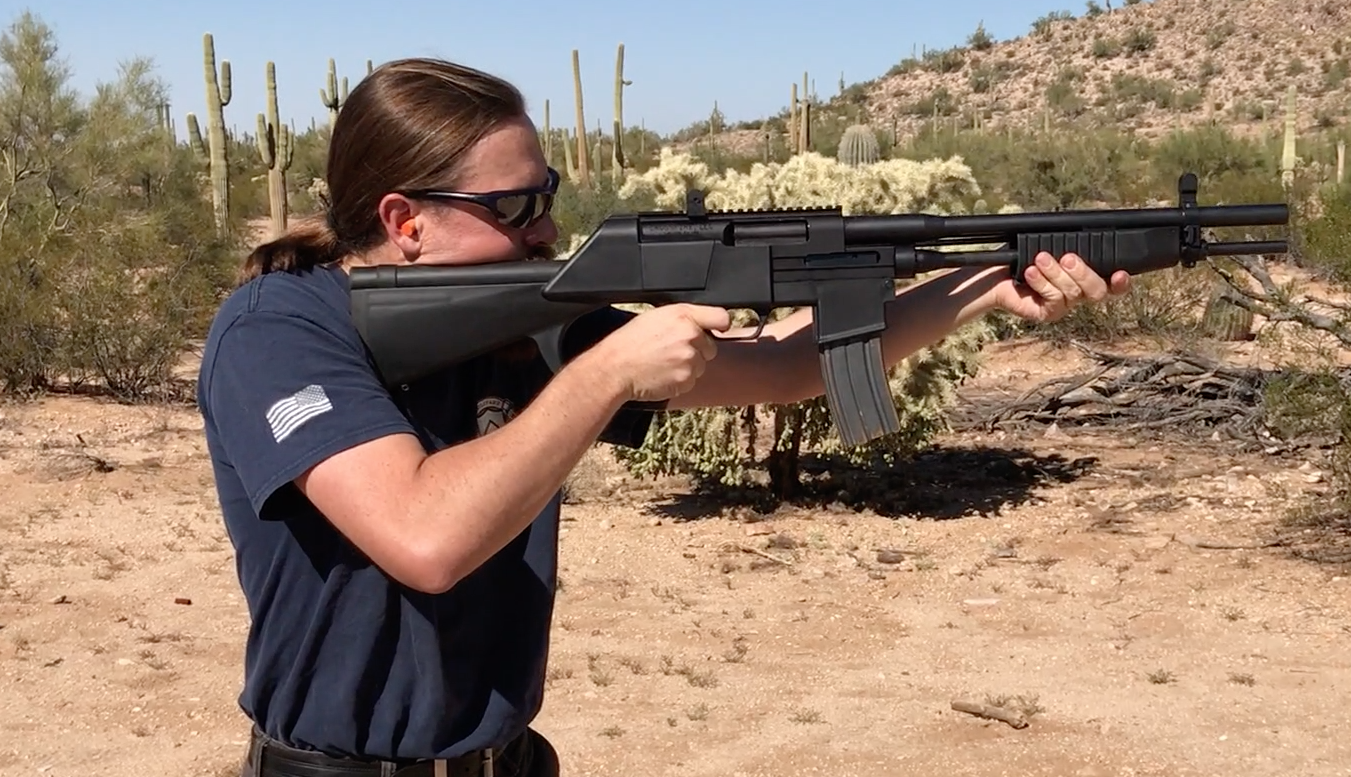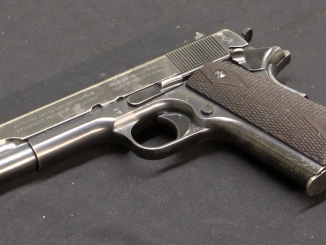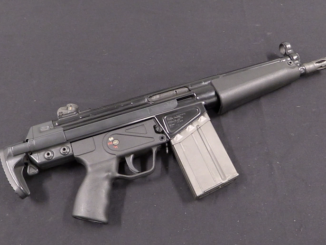The Winchester 1897 was the gun that really set the standard for the now-ubiquitous pump action shotgun. It was designed by John Browning, but was not the first pump action designed and sold. That credit goes to Christopher Spencer, who put the first pump action on the market in 1882. His patent on the concept (in conjunction with co-designer Sylvester Roper) forced competitors to develop workarounds (like the sliding trigger and grip of the Burgess pump shotgun) until 1893, when Winchester released Browning’s design. Winchester was promptly sued by Bannerman, who had purchased the production line and patents for the Spencer shotgun, and the court case did not finally resolve until 1897.
That was actually a potential blessing for Winchester, as the initial 1893 design was not designed to handle the new smokeless powder, and was only chambered for 2 5/8 inch shells. By the time Winchester won the patent case in 1897, it had become clear that smokeless powder was here to stay, and that sooner or later people would start running 2 3/4″ smokeless shells in their 1893 shotguns, which would break and potentially injure people. In a very early example of product liability recall, Winchester replaced the gun with the new, strong 1897 model and offered to exchange the old guns for new ones at no cost. The 1893 models thus turned in were destroyed by the company, leading to their scarcity today.
This particular lot at Rock Island includes examples of both a Winchester 1893 and 1897.




These are absolutely gorgeous pieces and testimony to ingenuity and state of industrial capability of the time. I myself own Winchester 1300 pump-gun so I have direct comparison of 100 years in development.
I have nearly all of majör pump gun brands and surprised seeing that Model 1300 being only side ejecting sample capable to load from magazine to chamber when the ejecting port looking downwards.
A ’97 is demonstrated in this film clip http://youtu.be/anmAvGrgzgQ The little old lady put the lack of a disconnecter to good use.
On a more serious note, the modern concept of product liability did not really exist in the 1800’s. I believe it was a court case involving Buick in the early 20th century that put the burden on the manufacturers to ensure that their products were safe; prior to that the burden was on the consumer (and still is in some parts of the world–one really large country in particular). Winchester probably did the recall to avoid bad publicity or just to do the right thing.
The 1897 Winchester “trench gun” was, in my opinion, the only shotgun preferable to Remington 870 pump mainly due to the ability to be “slam-fired” by holding the trigger down and “slamming” the bolt. I could get off at least three rounds per second with it but after two seconds was armed with a very short club … aka an empty weapon. The 870 can be modified to do the same. But in a close-quarter fight the ONLY weapon, in my opinion, that is better than either of these shotguns is the American 180 LSMG designed by Richard (Dick) Casull in Mid-1960s. Yep, he is the same Richard J. “Dick” Casull who was the Utah-born gunsmith and wildcat cartridge developer whose experiments with .45 Colt ammunition in the 1950s led to the creation of the development of the .454 Casull cartridge. In his younger years (the 1940s) he also worked with Elmer Keith during the period when he was developing the .44 Magnum and was a close friend of P. O. Ackley; the world famous wildcat cartridge developer and one of my favorite gunsmiths. Most people do not know that he also designed single action mini-revolvers chambered for the .22 rimfires. The American 180 weighs about 5½ pounds empty and 10-11 pounds fully loaded according to the capacity magazine used and has a rate of fire of 1200-1500 rounds per minute. It is chambered for either the .22 LR (Long Rifle rimfire) or even better the .22 ILARCO (for.22 Short Magnum rimfire) with 165, 220 or 275 rounds capacity magazines. The total weight of five .22LR rounds averages about 195 grains or about the same as one .45ACP Winchester Silvertip. A sustained burst will eat through body armor if held to one small area of the vest and is about the same firepower as a fully-loaded 12 gauge with a full magazine. It is also much lighter and manageable than the Atchison A-12 (AA-12) fully automatic shotgun In most “entry” situations, the American 180 may be the best weapon available and most certainly eclipses the 1897. But this in no way diminishes the utility of that weapon in its time.
“in a close-quarter fight the ONLY weapon, in my opinion, that is better than either of these shotguns is the American 180 LSMG designed by Richard (Dick) Casull in Mid-1960s.”
What about Thompson sub-machine gun with 100 round drum magazine?
“the only shotgun preferable to Remington 870 pump mainly due to the ability to be “slam-fired” by holding the trigger down and “slamming” the bolt.”
The Ithaca Model 37 (examples produced prior to 1975 according to: http://en.wikipedia.org/wiki/Ithaca_37 )also can be slam-fired.
That would certainly do the trick, although the Thompson with a 100 round drum is a heavy beast. Other good choices would be a Suomi or PPSh-41 SMG with a 70 round drum, an AK-74 with a 45 round RPK-74 magazine or an AR-15 with a 50 round drum. Personally I would consider them all better than any pump-action shotgun, but admittedly I don’t have any CQB experience. Nevertheless, the Suomi and PPSh-41 are very well proven in such conditions. The latter has probably cleared more rooms and trench sections than any other gun in history.
For a combat shotgun I would prefer a modern semi-auto gun over pump-action, preferably with an interchangeable box magazine. Semi-auto action allows you to fully concentrate on the enemy. The theoretically better reliability of the pump-action does not make up for the fact that you have to manually operate it. For example the Saiga and Vepr 12 are reliable (AK action) and can use up to 10 round magazines (up to 8 from the manufacturers). They are lighter than the AA-12, although they don’t offer full auto capability.
“Winchester probably did the recall to avoid bad publicity or just to do the right thing.” Maybe that plus the fact that it would be bad for business for all your customers to be walking around with the nickname “Lefty” because your product had blown their right arm off due to a mechanical failure; or worse yet, if they were being called “Stump” because they had lost both arms. In my experience it usually is mostly about the money…
Why don’t your youtube videos embed lately?
“it had become clear that smokeless powder was here to stay”
Also the Winchester redesigned older Model 1887 lever-action shotgun in 10 gauge to handle smokeless rounds and name it Model 1901. The http://en.wikipedia.org/wiki/Winchester_Model_1887/1901 states that Model 1901 was 10-gauge only to avoid redundant 12-gauge smokeless shotgun, but if so why Winchester don’t stop Model 1887 production and develop Model 1897 in 10-gauge version?
6102202680
‘Know of anyone who could reassemble my 1893 shotgun for me? I’m in over my head!
Much obliged – GBA